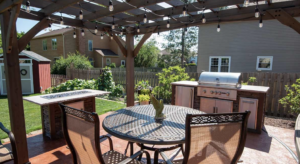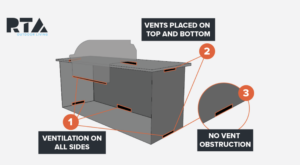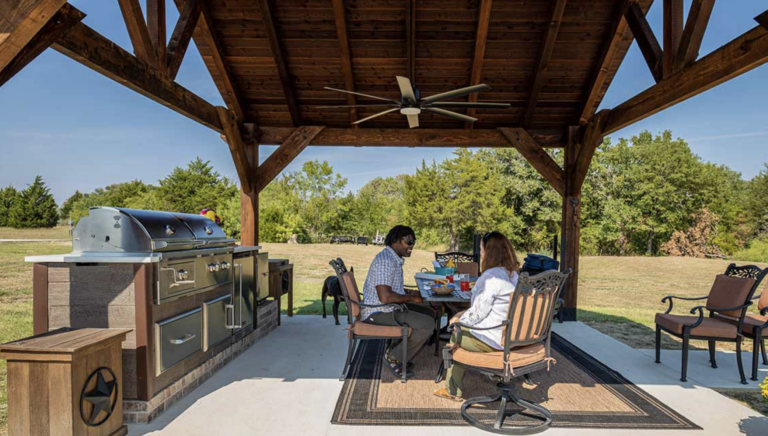The importance of outdoor kitchen ventilation is often overlooked, but it’s essential to the safety of the island.
In this blog, we seek to demystify the confusion surrounding outdoor kitchen vents and emphasize their importance. You’ll discover key concepts, safety considerations and concerns.
Island Vents per Fuel Type
Island vents refer to the direct source of ventilation on the outdoor kitchen. These will often take the form of stainless-steel vents placed on either side of an island. (This is what most appliance manufacturers recommend.) However, location matters depending on the fuel type used by the grill.
Propane is more dense than air, so it tends to sink. Therefore, it’s essential to place ventilation at the bottom of the island if the homeowner plans to use a propane grill. If ventilation is only at the top of the island, propane gas will build up. Let this buildup go too long, and the chances of the island exploding become a serious risk.

Unlike propane, natural gas is lighter than air, so it’s important for the ventilation to sit at the top of the island. If you make the mistake of putting vents at the bottom of the island for a natural gas grill, the gas will be unable to escape from the top of the island, creating the potential for an outdoor kitchen explosion.
It’s important to note some grill island manufacturers will put vents 6 inches below the actual top of the island. This can be problematic because gas will rise to the very top, meaning about 6 inches of gas vapor can accumulate before any gas is actually able to be ventilated.
Pay attention to the fuel type of the built-in grill and make sure the island manufacturer places vents correctly!
Heat Buildup
Heat buildup is another issue you must consider. Excessive heat can cause a fire in an outdoor kitchen. Even if the gas is being properly ventilated, heat is not escaping, which means the kitchen is still at risk for a fire.
For example, if the homeowner is using a liquid propane grill with vents at the bottom of the island, the island still will need ventilation at the top to allow for heat to escape. The same goes for other types of grills, like charcoal or pellet, which still produce copious amounts of heat that needs to be ventilated.
Hood vents are large, overhead ventilation systems designed to pull hot air away from an island. Hood vents will sit directly above the grill. Hoods also have baffle filters, which capture the grease coming off of the food, which reduces the risk of a grease fire.
Unlike island vents, hood vents are not required for every outdoor kitchen. If the island is in a completely open area, there’s no need for a hood. However, if the island is underneath any sort of roof, an outdoor hood vent becomes a requirement.
Outdoor hoods should have a 1,000 CFM blower at a minimum. This will ensure the hood is powerful enough to actually divert hot air away from the island.
Island Safety

Although there are many suitable prefabricated BBQ grill islands out there, you must ensure proper ventilation is included. Filter out the ones with no ventilation at all (there are some!).
Most appliance manufacturers recommend 20 square inches of ventilation on opposite sides of the island. This usually manifests as 20 square inches on both the left and right sides of the island. However, front to back ventilation is important.
Often, on prefabricated islands with ventilation, the vents used are indeed 20 square inches in size. But if the vents are stainless steel, about half of that space may be covered by the vent panel itself. You could only end up with about 10 square inches of actual airflow on each side of the island.
It’s not recommended to place an island directly against a wall because there is excessive heat coming off the grill that must be ventilated out of the area. Walls made from combustible materials make this scenario especially dangerous.
If the island is under a gazebo or a pavilion, hood ventilation is essential. Now, you must be concerned about gas and heat getting trapped overhead. This is especially true if the homeowners are using a natural gas built-in grill. Plus, there’s always the potential for a grease fire, which becomes far more dangerous with a flammable structure above the BBQ island.
Outdoor range hoods will funnel hot air away from the grill, as well as capture grease coming off of food. This makes an island safer to use underneath a gazebo or pavilion. Ensure there’s plenty of airflow around the perimeter of the outdoor kitchen.
Editor’s Note: This blog has been republished with permission from RTA Outdoor Living. Read the original post.



